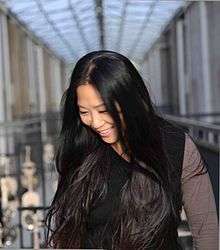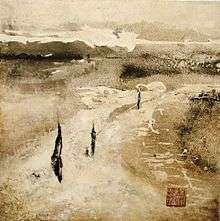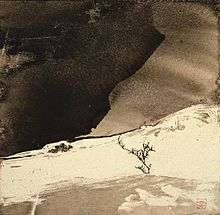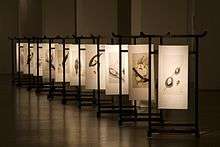Li Chevalier
| Li Chevalier 诗蓝 | |
|---|---|
 | |
| Born |
March 30, 1961 Beijing |
| Nationality | French |
| Education | Pg Dip. Fine Art - Central Saint Martins College of Art and Design London. |
| Website |
www |
Li Chevalier (Chinese: 诗蓝; pinyin: Shī Lán; born March 30, 1961) is a Chinese-born artist who moved to France and became a French citizen in 1986.[1] She is a member of the French National Fine Art Society (SNBA). She has been working at the crossroads of Europe and Asia for the past two decades . Her first retrospective exhibition was held in 2010 at the National Art Museum of China in Beijing. Her works are part of the permanent collection of this institution.
Li Chevalier is mostly known for her "Euro-Asian" artistic language, born out of blending western media and elements of eastern traditional art. Her exhibitions are mostly distinguished by her own particular spatial composition and scenographic design.

Biography
Li Chevalier (Shilan in Chinese) belongs to this generation of Chinese artists who found their "promised land" in France in the 80's. Recruited at the age of 15 by the Chinese Army as singer, she was demobilized 5 years later. As a young student, she participated in the vibrant intellectual debates centered around humanistic ideals that engulfed China in the early 80’s. Man and his alienated condition were at the center of discussions in a China traumatized by its dramatic past; this intellectual movement was interrupted towards late 1983 following the launch of a governmental campaign designed as "anti-spiritual pollution". Li Chevalier left China in 1984. Arriving in France, she decided to study political science and philosophy before embarking on studies in the visual arts, wishing to explore issues that had been left unresolved in her mind. Following undergraduate studies at the Institute of Political Science of Paris (1986–1990), she pursued a master's degree in political philosophy at the Sorbonne University and earned her M.A in Philosophy in 1990 (<Human screen> - an inevitable barrier for political ethics). This important detour into the study of politics and philosophy seemed unavoidable given the dramatic effect the Cultural Revolution had on Chevalier and fellow members of her generation. Philosophy has now become the foundation theme in her artistic expression. Li Chevalier found her artistic vocation in the 90's in the major European art cities, Florence, Paris and London.
She received her initial training in classical painting in Italy in the mid 1990s. She attended in France the master classes of French painters Rémy Aron, Thibaut de Reimpré and Pierre-Henry.
She received her nomination for membership of the French National Fine Art Society (SNBA) in 2003. Her work has been displayed annually in the new gallery of the Louvre since 2003. Chevalier has been among the selected artists representing SNBA at one of the major national art events in France, "L'Art en Capital", taking place in Paris’ Grand Palais.[2] In December 2004, the US Virginia Common Wealth University School of Art in Qatar hosted a major solo exhibition for Chevalier, presenting for the first time her experimental ink painting collection.
Chevalier went to London in 2003 to attend the Dali Studio at the Central Saint Martins’ College of Art and Design. She later enrolled in post graduate studies in fine art and received her degree in 2007. In the same year she won the competition for displaying her work at the Royal Academy summer exhibition in London. She was also shortlisted for Celeste Art Prize, an art competition organised by the London’s Goldsmith School of Arts. At that time the Rector of the University of the Art, London, Lord Michael Bichard discovered Chevalier's work and became a collector.
Chevalier embarked on the Chinese art scene in 2007. She met the Chinese art theorist Peng Feng, Director of the Chinese Pavilions at the 54e Venice Biennale, who became the art curator for Chevalier's major exhibitions in three Chinese National Museums.
Major exhibitions
Four major solo exhibitions of Li Chevalier have been successively presented by the National Art Museum of China (2010),[3] the Today Art Museum in Beijing (2010),[4] the Shanghai Art Museum (2011), the National Centre for the Performing Arts (NCPA) China (2013). Chevalier's work became part of the permanent collection of the National Art Museum of China Namoc in 2010. Two of her major works became part of the French Embassy's art collection and are hanging presently at the reception salon of the French Residence in Beijing,[5] next to the works of two other Chinese born French artists Zao Wou-Ki and Chu Teh-Chun.[6]
In 2007, Li Chevalier's work was shown at the Royal Academy of Arts London Summer exhibition. Her works appeared also in some major international art fairs and exhibitions, such as the Art Salon of the French National Fine Art Society at Carrousel du Louvre (2003), l'Art en Capital at the Grand Palais (2007,2011), London Art Fair (2007), Glasgow Art Fair (2008), Northern Art Fair (2008), Shanghai Art Fair (2008), Beijing International Art Fair (2011), the Doha National Art Gallery Al Bida.
In 2014, under the patronage of the former French Prime Minister and Mayor of Bordeaux Alain Juppé and in the framework of the celebration of the 50th anniversary of France-China diplomatic relations, the Submarine Base Contemporary Art Centre of Bordeaux presented her solo show <L'art du croisement>.[7] Li Chevalier's works became part of the permanent collection of the Institute Bernard Magrez in 2014.
Her other art events include exhibitions at the Wuhan Art Museum (2010), the New Vision Art Museum (2010), Huantie Art Museum Beijing (2009), Shangshang Art Museum Beijing (2010), Colombia University art gallery, Korean Cultural Art Centre in Beijing, Aslem Art Museum in Sweden (2015), The Fine Art Museum of Saint Petersburg University in Russia (2015).[8]
Artistic style
Experimental ink painting
Ink and mixed media on canvas 150/150 cm - 2014

Ink and mixed media on canvas 150/150 cm - 2014

Ink and mixed media on canvas 150/150 cm - 2007

Ink and mixed media on canvas 100/100 cm - 2004

Ink and mixed media on canvas 150/150 cm - 2014
Ink and mixed media on canvas 150/150 cm - 2014

Installation, Installation, National Theater for Performing Arts (NCPA) Beijing China - 2013
Installation, Base sous marine Bordeaux - 2014

Installation, Base sous marine Bordeaux - 2014

National Fine Arts Museum, Beijing China - 2010

Today Art Museum, Beijing China (2010)

Shanghai Fine Arts Museum, China - 2011
In a climate of heightened cultural globalization, two opposing trends confront the Chinese art scene: a radical defense of the national cultural identity, or a massive invasion of Western art tradition like "Political Pop", "cynical realism" or European Dadaism; the nomad artist Li Chevalier joined those who sail on a third road, a new art movement named "Experimental Ink Painting". After being trained in Italy, where the spirit of the Renaissance is still and everywhere present and in London, Central Saint Martin’s college of Arts and Design rather known for its avant-gardisme,[9] Li Chevalier made a radical return to explore her cultural roots and started her adventure in experimental paintings combined with Chinese ink, incorporating western art practices in order to enlarge its expression. She has become today the most fervent promoter of this movement in Europe.
"Ink and in between" is the title of the text that the French sinologist François Jullien devoted to her solo show "Art and fusion" in 2014. "Ink", as departure point, a singular artistic language of the far East. "In between", a spatial navigation between different cultures, a temporal dialogue between past and present. Li Chevalier sees, in ink painting's fluidity, in its inability to produce rationally organized geometric shapes, through its disinterests in the conquest of objectivity, a perfect representation of oriental culture. Faithful to the semi-abstract spirit of Chinese traditional painting "Big picture has no form", Li Chevalier pushes on step further toward abstraction and experimentation. She works on canvas instead of on rice paper,[10] integrating a textured surface (pigments, mineral chips, sand, paper collage and calligraphy). Other experimentations led her to the diversification of formats, from small to monumental, from rectangular to square. Finally, a scenic touch allows her ink paintings to occupy the whole exhibition space, approaching the spirit of installation. If the spiritual orientation of her research moves away from political and social issues, Li Chevalier is convinced to have taken a strong position on a vital contemporary issues, that is to re-singularize the world's artistic language against global standardization. It is an issue that goes beyond any single nation and touches on the world cultural biodiversity.
Aesthetic and spiritual quest
Departing from the satirical pop art trends dominating the contemporary Chinese art landscape, Chevalier's art expresses a strong orientation for an aesthetic and spiritual quest.
On her semi-abstract canvas, the symbolic function of black and white plays the role of a visual representation of an oriental cosmic vision. Contrary to some western philosophical outlooks which value grandeur, eternity and absolutes, the Zen aesthetic posture perceived in Chevalier's works conveys the qualities of modesty, humanity and illusiveness. It depicts the fleeting destiny of human existence. A peculiar predilection for simplicity and moderation is noticeable in her works. Her choice of forms is reduced to their simplest expression; colours to subtle tones. She adopts naturally curved shapes rather than hard edges. The transparent grey and fluid brush strokes, suggestive of cascading water, which is simultaneously controlled and uncontrollable, can be seen as a metaphorical language for fate.
Landscape is a major theme in Chevalier's works. Unlike the geometric harmony of the French garden, the landscapes that she portrays are intentionally spontaneous. In his book Le sens du Beau, the French philosopher Luc Ferry suggests that the French Garden is a rationalist expression of abstract mathematical reason by which one reaches the truth and the divine order.[11] Chevalier's nature could then be compared to the virginal nature of the Payne spirit cherished by Western romanticism. Intuition is preferred to intellectual order; spontaneity prevails over geometric proportion.
Landscape is a pretext to express her "philosophical astonishment," the spiritual dimension is thus the essential value of her works, heir, in some way, of the traditional Chinese literati art.
Facing the nature and the mystery of the universe, far from a bold onto-theological conviction or belief, Li Chevalier depicts "Toris", spiritual gates standing at the entrance of Japanese temples, or a scholars' bench at the summit of a mountain, inviting the viewer to afford the time to question the sense of life. The Christian cross witnesses the irresistible human impulse toward transcendence; The strong presence of Chinese stone steles, the Breton and Corsican menhirs bring us back to that same fascination that Victor Segalen felt toward these carved stones that spangle the earth, who are set in the horizon as landmark and relay the irreversible course of time between past and present. They announce the brevity and fragility of life and express the human desire for the eternal.[12]
On her semi-abstract canvas, the symbolic function of black and white plays the role of a visual representation of an oriental cosmic vision. Contrary to some western philosophical outlooks which value grandeur, the Zen aesthetic inspired posture perceived in Chevalier's works conveys the qualities of humility and illusiveness. It depicts the fleeting destiny of human existence. A peculiar predilection for simplicity and moderation is noticeable in her works. Her choice of forms is reduced to their simplest expression; colors to subtle tones. She adopts naturally curved shapes rather than hard edges. The transparent grey and fluid brush strokes, suggestive of cascading water. Given the spontaneous flow of water on large scale canvas, which so often escapes the control of the artist, every step forward for her is a lesson on humility. The no duplicable forms enforce the sense of uniqueness of art work and the origin of its value. Such uniqueness can be seen as a metaphorical language for the value of life.
Beauty and Humanism
Ambitioning a re-conquest of beauty in art, Li Chevalier collaborated in 2014 with the French philosopher Luc Ferry, the Chinese art critic Peng Feng, and the Director of the Central Academy of Fine Arts of China, Mr Pan Gong Kai on a series of conferences in China on the theme "The birth of modern aesthetics and the criterion of beauty".
After devoting her post graduate degree in philosophy on the topic "Man as inevitable barrier for political ethics" at the Sorbonne in 1990, Li Chevalier submitted her post graduate thesis in Fine Arts on the theme "Art and Beauty" at Central Saint Martin’s College of Art and Design in London, an institution known for its avant-garde trend where aesthetic transgression is the watchword. "In search of lost beauty" was the title of two of her paintings presented at the graduation exhibition, an open revolt against the critics on her excessive aesthetic sensitivity by her professor. Li Chevalier declare her conviction that no true elation may arise from an artwork without the prism of aesthetic emotion. She believes that aesthetic emotion goes hand by hand with deep attachment to human values. Li Chevalier thus claims to be in communion with Anselm Kiefer who, in an interview in the Financial Times, at the occasion of his show at the Royal Academy of the Arts in London declared:"You cannot avoid beauty in art!"
Li Chevalier's childhood witnessed the human madness of the Cultural Revolution: human beings been reduced to the status of political instrument, assault against beauty, considered as a bourgeois disease, flooding into every corner of the private sphere of the Chinese people. She believes that the instrumentalization of human beings entails necessarily the extermination of his desire for the beautiful, for, neither the sensitivity nor the aesthetic emotion belong to things. In a lecture given at the Institute Bernard Magrez in Bordeaux in May 2014, Li Chevalier recited a text from "The five meditations" by the French Academician François Cheng, which, according to Li Chevalier, is the most beautiful synthesis of a humanist aesthetics: "We could imagine a universe that would only be true, without the slightest idea of beauty touching our spirit... it would be like dealing with a range of "robots"and not life. In fact, the concentration camps of the twentieth century have provided us a terrible example of such..."
Installation
Installation and scenography
Li Chevalier's exhibitions and installations are mostly known for their scenographic design, and for her site-specific spatial compositions which carry theatrical qualities. Emphasis is given on the use of light, environment and sound, but also to the visitors' physical participation in the event, all contributing to a sensory experience which generates enjoyment in front of the work.
Cantabile per archi
As a prelude to a concert conducted by Paris Opera chef Philippe Jordan in Beijing in 2013, Li Chevalier took over the The National Center for the Performing Arts (NCPA) with her monumental installation "Cantabile per archi" a work inspired by a piece from Latvian composer Peteris Vasks. Various cultural artifacts gathered in a visual symphony expressing Li’s motto "respecting peculiarity combined into harmony".[13]
"Cantabile per archi" is composed of over 200 string instruments all dressed up with artist's trade mark ink painting, photography and calligraphy. This installation presented a vision of a forest of violin in the vast nature, heartrending cries of despair, vectors of a tragic dichotomy between the humanist ideal of the composer and the devastating reality that struck his fellow people. By this installation, Li Chevalier intended to creates a resonance between two distant countries gone through similar historical drama, hyphen of two minds, two art forms.
Steles of light
In 2012, on the occasion of the celebration of the 100th anniversary of the publication of "Steles" by the French author Victor Segalen, the National Library of China presented an installation of Li Chevalier "The Steles of Light". This installation was composed of eighty-one steles form of light boxes mounted with lithographs of the ancient steles from different centuries. These stone steles are preserved in the Museum of Xi'An. The number 81 was chosen by Segalen for the draw of the original edition of his book. It corresponds to the number of slabs of the last circle of a terrace on the altar of the Heaven Temple in Beijing. Glued on metal holder and lit up from within, the steles of poems, like the stone steles at the entrance of temples or those that stand like lost in the Chinese landscapes, with their praise of a great man or memory of a poet, highlight the imprint of a passage, the shadow of a lost soul. For the artist, these steles bearing a trace of a civilization are witness to the impermanence of life, but also the deep human desire for eternity. Impermanence and desire for eternity are also a familiar theme in Li Chevalier's paintings, by her frequent use of steles lithography collages and presence of shadow-figures that evoke Celtic lands and Breton menhirs.
Between music and visual art
Chevalier’s childhood was one in which she was exposed to and offered education in the arts. This led her, in the first instance, into the field of music. At the age of 15, she was selected by the Chinese Army’s Operatic troupe to be trained as a singer. Music remains her lifelong passion, alongside her professional practice as a visual artist. She has sung as soprano in the Paris Orchestra’s Choir under the direction of Arthur Oldham and Semyon Bychkov, She performed frequently under the direction of the French conductor Hugues Reiner.
She has collaborated with the violin super soloist of Paris Opera, Frederic Laroque, since 1991, as well as staged two concerts in association with the former China Radio Orchestra and the China Film Orchestra.[14] A solo exhibition of Chevalier in December 2004 entitled <Painting music>, under the patronage of the Qatar Foundation, was associated with a concert performance by the String Quartet of Paris Opera (QOP). In 2010, she staged a solo exhibition <Visual Symphony> at the French Cultural Centre in Beijing paying homage to the Latvian composer Peteris Vasks.
Music has been one of the recurrent themes in her later art works. The painting entitled I hear the water dreaming exhibited at the Royal Academy of Art in London in 2007, is an homage paid to the Japanese composer Takemitzu. Her painting Symphony of Destiny, now part of the French Embassy art collection, is a homage to Beethoven. Other examples of her works related to music are: The rite of spring by Stravinsky (private collection in the US), the Transfigured Night (Verklärte Nacht) composed by Arnold Schoenberg and the Two voice invention by Bach. In 2011, Her major installation work displayed at the Shanghai Art Museum was strongly inspired by the Belgium composer Dirk Brosse's violin concerto: Black , white and in between.
Major works
- 2004 : Pathetical, 100 cm x 100 cm, mixed media on canvas; private collection in France
- 2007 : The Voice of Silence, 137 cm x 137 cm, mixed media on canvas; private collection in the UK, work displayed at the Royal Academy of London
- 2008 : La tolérance du vide, 150 cm x 150 cm, mixed media on canvas; work displayed at the Grand Palais in 2008
- 2008 : Transfigured Night, 150 cm x 150 cm, mixed media on canvas; work displayed at the National Museum of China
- 2009 : Le Sonate d'hiver, 175 cm x 175 cm, mixed media on canvas; work displayed at the Today Art Museum in 2010
- 2010 : L'Origine, 175 cm x 175 cm, mixed media on canvas; collection of French Embassy in China
- 2010 : Les stèles de Lumière, installation; displayed at the National Museum of China
- 2010 : Symphony of Destiny, 300 cm x 195 cm, mixed media on canvas; collection of French Embassy in China
- 2010 : Beyond the horizon, 300 cm x 195 cm, mixed media on canvas; work displayed at retrospective Li Chevalier, National Museum of China
- 2010 : Sublimated Touch, mixed media on canvas; work displayed at Today Art Museum
- 2010 : Waiting, 300 cm x 195 cm, mixed media on canvas; permanent collection at the National Museum of China
- 2011 : Black and White and In Between, installation; displayed at Shanghai Art Museum
References
- ↑ Les combats intérieurs de Li Chevalier Connaissance des Arts
- ↑ LI CHEVALIER
- ↑ Li Chevalier's hybrid vision spans two continents
- ↑ Li CHEVALIER | Institut Culturel Bernard Magrez
- ↑ Li Chevalier, peintre trait d'union
- ↑ CCTV-Exposition de Li Chevalier
- ↑ Li Chevalier : l'Art du Croisement
- ↑ Le paris des arts - À Pékin, avec des artistes qui défendent leur art
- ↑ Li, l' artiste du Gao Ya
- ↑ Beaux arts magazine - LI CHEVALIER
- ↑ Conférences de Luc Ferry
- ↑ Li Chevalier by Gérard XURIGUERA
- ↑ Silent sounds of cross cultural art
- ↑ Festival Croisements 2013
Links
- Site officiel de Li Chevalier
- 今日数字美术馆
- www.li-chevalier.com
- LI CHEVALIER, préface par Gérard XURIGUERA
- Sous l'œil inspiré de Li Chevalier", Arnaud de la Grange, correspondent du Figaro en Chine, mai 2010
- deux œuvres de Li Chevalier pour l'Ambassade de France en Chine, Latitue France, Denis Lavalle, Conservateur Général du Patrimoine de France, 13 juillet 2011
- Rétrospective Li Chevalier au Musée National des Beaux Arts de Chine, Quotidien du peuple, 20 septembre 2010
- Exposition de Li Chevalier, Télévision Centrale de Chine, 12 septembre 2010
- Radio Chine Internationale, 26 octobre 2011
- http://www.lichevalier.com/blog/index-693752.html
- "La voix de la vie" selon Li Chevalier, Latitude France, 10 septembre 2010
- Rétrospective Li Chevalier, Site officiel du Musée National des Beaux Arts de Chine, 8 décembre 2010
- http://www.namoc.org/msg/zhanlan/201011/t20101126_131960.html
- officiel du Musée des Beaux Arts de Shanghai
- Site officiel du Today Art Museum
- Solo exhibition of Li Chevalier opens at the National Art Museum of China, Télévision centrale de Chine CCTV, 12 septembre 2010
- Télévision de Pékin, 21 novembre 2011
- Painting and culture, Bon TV, English Blue Ocean Satellite TV, 3 octobre 2010
- Fresh ink: Li Chevalier's hybrid vision spans two continents, Global Times, 9 décembre 2010
- Fine Artist, Global Times, 18 mars 2010
- Beijing-born painter back to conquer China, China Daily, 20 mai 2010
- Reportage CCTV, 21 mars 2011
- (French) « Li Chevalier » sur l'encyclopédie audiovisuelle de l'art contemporain
